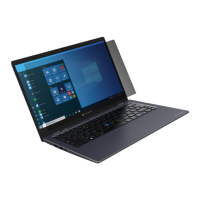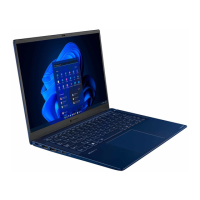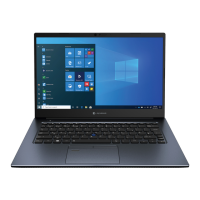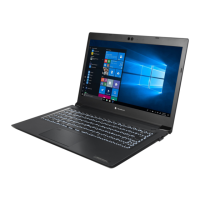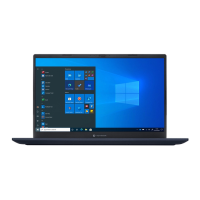Do you have a question about the dynabook Portege X30L-G and is the answer not in the manual?
Details copyright, disclaimer, and trademark information for the manual and product.
Provides information regarding compliance with regulations like FCC and EU directives.
Details compliance with FCC RF exposure and interference requirements.
Warns about chemicals in the product known to cause cancer or birth defects.
Outlines technical data controlled under U.S. Export Administration Regulations.
Declares compliance with European Directives, including CE marking and RoHS.
Information for Japan regarding Class B digital devices.
Details Canadian regulations for digital apparatus and radio noise emissions.
Details requirements for RF exposure compliance and antenna placement.
Specifies restrictions for indoor use and potential interference from radars.
Instructions for proper disposal of products, including environmental considerations.
Guidance on collecting and disposing of batteries separately from household waste.
Statement on compliance with the EU chemical regulation REACH.
Licensing information for video standards like AVC, VC-1, and MPEG-4.
Details the dual license for the OpenSSL toolkit and its terms.
Outlines the license terms for the FreeType Project software.
Information about the computer's compliance with ENERGY STAR guidelines for energy efficiency.
Provides general safety precautions to reduce the risk of injury or damage.
Lists the items included with the computer for verification.
Explains formats used in the manual for clarity.
Provides initial steps and advice for first-time computer use.
Step-by-step guide on how to connect the AC adaptor for charging and power.
Instructions on how to open the display panel safely.
Explains how to turn on the computer's power for the first time.
Guidance on the initial setup process after turning on the computer.
Points to resources for learning Windows operation.
Explains Windows Hello for secure sign-in using biometrics or PIN.
Describes different modes for turning off the computer.
Describes Sleep Mode for interrupting work and saving power.
Explains Hibernation Mode for saving system state and power.
Information about the hidden partition for system recovery options.
Step-by-step guide on creating recovery media for system restoration.
Shows the front view of the computer with the display closed.
Identifies components on the left side of the computer.
Identifies components on the right side of the computer.
Shows the back view of the computer and identifies cooling vents.
Shows the underside of the computer, identifying cooling vents and speakers.
Describes the front view with the display panel open.
Explains how to use the touch screen gestures and interactions.
Details the gestures and functions of the touch pad.
Describes the types of keys and layout of the keyboard.
Details the function keys (F1-F12) and their combinations with FN.
Guides on enrolling and using the fingerprint sensor for sign-in.
Introduces the section on battery types, usage, and handling.
Provides important safety precautions for handling the battery pack.
Explains how to charge the battery pack and the charging process.
Information about the memory media slot and supported card types.
Details the HDMI out port for connecting external displays.
Explains how to use USB Type-C™ adapters for enhanced capabilities.
Information on the computer's built-in Ethernet LAN support.
Information on the computer's wireless display capabilities.
Describes audio control functions like Volume Mixer and Microphone Level.
Describes pre-installed utilities and how to start them.
Configuration tool for BIOS, power, USB charge, keyboard, and system passwords.
Explains setting up User and Supervisor passwords for computer access.
Utility for software updates, diagnostics, and troubleshooting.
BIOS setup utility for viewing and changing system settings.
Utility to erase internal storage drive and partitions.
Describes unique or advanced features for convenience.
Guidelines for effectively identifying and resolving issues.
Basic checks to perform before deeper troubleshooting.
Steps to analyze symptoms and gather information for problem diagnosis.
Common scenarios and solutions when the computer or programs stop responding.
Steps to take if the computer fails to power on.
Explains automatic shutdown due to overheating and solutions.
Troubleshooting steps for issues related to AC adaptor power.
Troubleshooting common battery-related problems.
Troubleshooting steps for the computer failing to power on.
Resolving keyboard issues such as garbled screen output.
Troubleshooting computer boot issues and slow performance from storage.
Resolving problems with the touch pad not working or sensitivity issues.
Troubleshooting common USB mouse problems.
Steps to resolve issues with registering or deleting fingerprints.
Troubleshooting no sound or annoying sounds from the audio system.
Troubleshooting external monitor connection and display issues.
Information on how to contact support for further assistance.
Summarizes the technical specifications of the computer.
Provides the physical dimensions of the computer.
Lists operating and non-operating environmental conditions.
Details the power requirements for the AC adaptor and computer.
Specifications for AC power cords and connectors.
Information regarding wireless technology interoperability and standards.
Explains wireless LAN functions, security, and card specifications.
Specifies maximum power output for various wireless modes.
Compliance information for Canada's Industry Canada (IC) regulations.
FCC compliance information for digital devices and RF exposure.
Important notices and indications for using equipment in Japan.
Introduces accessibility options provided by Windows 10.
Lists special features like automatic power off, sleep/hibernation, and heat dispersal.
Guides on how to diagnose and resolve computer problems.
Discusses CPU performance factors and conditions.
Factors affecting battery life and performance over time.
Details copyright, disclaimer, and trademark information for the manual and product.
Provides information regarding compliance with regulations like FCC and EU directives.
Details compliance with FCC RF exposure and interference requirements.
Warns about chemicals in the product known to cause cancer or birth defects.
Outlines technical data controlled under U.S. Export Administration Regulations.
Declares compliance with European Directives, including CE marking and RoHS.
Information for Japan regarding Class B digital devices.
Details Canadian regulations for digital apparatus and radio noise emissions.
Details requirements for RF exposure compliance and antenna placement.
Specifies restrictions for indoor use and potential interference from radars.
Instructions for proper disposal of products, including environmental considerations.
Guidance on collecting and disposing of batteries separately from household waste.
Statement on compliance with the EU chemical regulation REACH.
Licensing information for video standards like AVC, VC-1, and MPEG-4.
Details the dual license for the OpenSSL toolkit and its terms.
Outlines the license terms for the FreeType Project software.
Information about the computer's compliance with ENERGY STAR guidelines for energy efficiency.
Provides general safety precautions to reduce the risk of injury or damage.
Lists the items included with the computer for verification.
Explains formats used in the manual for clarity.
Provides initial steps and advice for first-time computer use.
Step-by-step guide on how to connect the AC adaptor for charging and power.
Instructions on how to open the display panel safely.
Explains how to turn on the computer's power for the first time.
Guidance on the initial setup process after turning on the computer.
Points to resources for learning Windows operation.
Explains Windows Hello for secure sign-in using biometrics or PIN.
Describes different modes for turning off the computer.
Describes Sleep Mode for interrupting work and saving power.
Explains Hibernation Mode for saving system state and power.
Information about the hidden partition for system recovery options.
Step-by-step guide on creating recovery media for system restoration.
Shows the front view of the computer with the display closed.
Identifies components on the left side of the computer.
Identifies components on the right side of the computer.
Shows the back view of the computer and identifies cooling vents.
Shows the underside of the computer, identifying cooling vents and speakers.
Describes the front view with the display panel open.
Explains how to use the touch screen gestures and interactions.
Details the gestures and functions of the touch pad.
Describes the types of keys and layout of the keyboard.
Details the function keys (F1-F12) and their combinations with FN.
Guides on enrolling and using the fingerprint sensor for sign-in.
Introduces the section on battery types, usage, and handling.
Provides important safety precautions for handling the battery pack.
Explains how to charge the battery pack and the charging process.
Information about the memory media slot and supported card types.
Details the HDMI out port for connecting external displays.
Explains how to use USB Type-C™ adapters for enhanced capabilities.
Information on the computer's built-in Ethernet LAN support.
Information on the computer's wireless display capabilities.
Describes audio control functions like Volume Mixer and Microphone Level.
Describes pre-installed utilities and how to start them.
Configuration tool for BIOS, power, USB charge, keyboard, and system passwords.
Explains setting up User and Supervisor passwords for computer access.
Utility for software updates, diagnostics, and troubleshooting.
BIOS setup utility for viewing and changing system settings.
Utility to erase internal storage drive and partitions.
Describes unique or advanced features for convenience.
Guidelines for effectively identifying and resolving issues.
Basic checks to perform before deeper troubleshooting.
Steps to analyze symptoms and gather information for problem diagnosis.
Common scenarios and solutions when the computer or programs stop responding.
Steps to take if the computer fails to power on.
Explains automatic shutdown due to overheating and solutions.
Troubleshooting steps for issues related to AC adaptor power.
Troubleshooting common battery-related problems.
Troubleshooting steps for the computer failing to power on.
Resolving keyboard issues such as garbled screen output.
Troubleshooting computer boot issues and slow performance from storage.
Resolving problems with the touch pad not working or sensitivity issues.
Troubleshooting common USB mouse problems.
Steps to resolve issues with registering or deleting fingerprints.
Troubleshooting no sound or annoying sounds from the audio system.
Troubleshooting external monitor connection and display issues.
Information on how to contact support for further assistance.
Summarizes the technical specifications of the computer.
Provides the physical dimensions of the computer.
Lists operating and non-operating environmental conditions.
Details the power requirements for the AC adaptor and computer.
Specifications for AC power cords and connectors.
Information regarding wireless technology interoperability and standards.
Explains wireless LAN functions, security, and card specifications.
Specifies maximum power output for various wireless modes.
Compliance information for Canada's Industry Canada (IC) regulations.
FCC compliance information for digital devices and RF exposure.
Important notices and indications for using equipment in Japan.
Introduces accessibility options provided by Windows 10.
Lists special features like automatic power off, sleep/hibernation, and heat dispersal.
Guides on how to diagnose and resolve computer problems.
Discusses CPU performance factors and conditions.
Factors affecting battery life and performance over time.
| Graphics | Intel Iris Xe Graphics |
|---|---|
| Operating System | Windows 10 Pro |
| Bluetooth | Bluetooth 5.1 |
| Display | 13.3-inch FHD (1920 x 1080) |
| Weight | 0.87 kg |
| Ports | HDMI, microSD card reader, Headphone/microphone combo jack |
| Wireless | Wi-Fi 6 |
| Security | TPM 2.0 |

